
Castles In The Sun
by W. Ruth Kozak
MONEMVASIA: A Medieval Treasure
 Hidden on the slopes of a great rock known as the Gibraltar of Greece, Monemvasia is one of those rare treasures that tourists usually by-pass. It’s a magical experience visiting this little medieval site. The entire town is walled and invisible from the shore. The steep rock, crowned with its Venetian fortress, is connected to the mainland by a narrow causeway. Motor vehicles are prohibited, but a mini bus takes you free of charge to the old city gates.
Hidden on the slopes of a great rock known as the Gibraltar of Greece, Monemvasia is one of those rare treasures that tourists usually by-pass. It’s a magical experience visiting this little medieval site. The entire town is walled and invisible from the shore. The steep rock, crowned with its Venetian fortress, is connected to the mainland by a narrow causeway. Motor vehicles are prohibited, but a mini bus takes you free of charge to the old city gates.
Monemvasia was my first stop in the Peloponnese on my quest to visit Venetian castles. As I entered the L-shaped tunnel, through the thick stone vaulted gateway I was immediately transported into another age. The narrow cobbled streets wind up the side of the rock. Many of the old buildings are restored in the ‘new town’. A few are small hotels and there are interesting little shops and cafes. Farther up most of the old town is in ruins, except for a few houses like the home of Yannis Ritsos, who was one of Greece’s most well-known poets.
Known in medieval times as the “Rosemary of the East,” Monemvasia got it’s name, which means “Sole Entrance,“ because the only entry is through the fortified tunnel. The town itself is completely walled and not visible from the shore. The Venetians called it Malvasia. It became renown for the excellent wine produced there.
The city was occupied by the Venetians in 1417 after pirate raids caused the inhabitants to ask for their help. Lying on an important trade route it was an attraction for the pirates who took not only merchandise and animals, but people who were sold as slaves. When Venetian power began to wane in 1719 Venice sold it to the Turks for 30,000 gold florins and the people were forced to relocate. Later when Turkey declared war on Venice the city was recaptured.
KORONI: A Romantic Interlude
 From Monemvasia I took the early morning bus heading for Koroni, another Venetian town. After a circuitous route through Sparta, I arrived at Koroni that evening. The castle of Koroni was lit by a mystic green light. Above its turrets, Mars blinked its red beacon; a crescent moon illuminated the sky over the twinkling lights of the village; little kaikis bobbed on the moonlit sea.
From Monemvasia I took the early morning bus heading for Koroni, another Venetian town. After a circuitous route through Sparta, I arrived at Koroni that evening. The castle of Koroni was lit by a mystic green light. Above its turrets, Mars blinked its red beacon; a crescent moon illuminated the sky over the twinkling lights of the village; little kaikis bobbed on the moonlit sea.
I chose a pleasant sea-side taverna and took a table nearest the water to enjoy a meal of tender kalamarakia (squid) and marouli (lettuce) salad served with capers and olives, and a half carafe of krasi aspro (white wine). While I dined I was serenaded by a trio of Romanian musicians.
Koroni is a delightful old Venetian town. Its narrow cobbled streets and stairways, lead up to the castle most of which is now occupied by a convent. Once it was a Venetian naval fortress located on the Messinian Gulf protecting the Venetian waterways. Like its sister cities Methoni and Monemvasia, it was an important urban settlement, of strategic importance during the Middle Ages as a port for Venetian ships headed East.
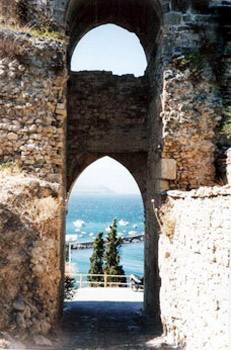 The old town of Koroni has long since fallen into ruin, but the Venetian architecture has been preserved, with wrought iron balcony railings, arched windows and doors. The largest, two-storied mansions and public buildings are on the waterfront, while higher up are the smaller Laika (folk) houses with small inner courtyards. One distinctive feature of the Koroni houses are the curved tile roofs and unusual terracotta eave decorations: instead of the usual palmettes, these are like small winged angels.
The old town of Koroni has long since fallen into ruin, but the Venetian architecture has been preserved, with wrought iron balcony railings, arched windows and doors. The largest, two-storied mansions and public buildings are on the waterfront, while higher up are the smaller Laika (folk) houses with small inner courtyards. One distinctive feature of the Koroni houses are the curved tile roofs and unusual terracotta eave decorations: instead of the usual palmettes, these are like small winged angels.
Koroni’s beaches are an important nesting area for the endangered and protected loggerhead sea turtles, caretta caretta. These turtles have been nesting along the coast of the Peoloponnese for thousands of years. The females return to the beach where they were hatched to lay their eggs. There are about 800 protected nests on the beaches in this area. Unfortunately I didn’t see any of these rare turtles as their hatching season was over mid August.
It’s a twenty minute hike to get to the fabulous Zaga Beach, which is a long curve of sandy shore behind the hillside. It was well worth the effort to get there and I spent a glorious afternoon lounging on a beach chair and swimming with a view of the castle above.
I would have liked to stay much longer in Koroni, but remembering my quest for castles in the sun, I set off for Methoni.
METHONI MAGIC
 Which set of the many instructions, bus schedules, and info that I was given by Greek locals would prove to be the right one? After various suggestions I decided to go with the English speaking baker who even drew me a map to explain which village to get off to catch the bus to Pylos/Methoni which, he said, went past every hour. According to his directions, I disembarked at the cross-roads at a village called Rozymalos and waited at a kafeneion for just over an hour until the bus finally arrived.
Which set of the many instructions, bus schedules, and info that I was given by Greek locals would prove to be the right one? After various suggestions I decided to go with the English speaking baker who even drew me a map to explain which village to get off to catch the bus to Pylos/Methoni which, he said, went past every hour. According to his directions, I disembarked at the cross-roads at a village called Rozymalos and waited at a kafeneion for just over an hour until the bus finally arrived.
The baker‘s instructions were wrong. The bus wasn’t going to Methoni. Instead, I was dumped off in the town square of Pylos. End of the line. Eleven kilometers to go. Fortunately I have enough rudimentary Greek to ask directions. A pharmacist explained that the bus depot was right across the street and the Methoni bus runs often. So I had a tiropita and iced tea and waited.
When I eventually arrived at Methoni the town seemed deserted. There were no taxis in sight, it was mid-afternoon and all the Greeks were having their siesta. I saw a sign pointing “to the beach” and followed the road until I saw “Methoni Camping.” I set up my tent at the campsite, and went to the beach for a swim. The beach appeared to be all stones, sloping down into the sea but the sea bed was pure sand. Not a stone or a shell and no sea-weed either! Farther along the beach I got my first glimpse of Methoni’s immense castle.
Methoni is one of the most historic regions of the Peloponnese with a long cultural history. The ancient city Abeloessa Adassos was mentioned by Homer as one of the seven cities that Agamemnon offered Achilles to appease his anger after Agamemnon had ‘stolen’ Achilles’ favourite woman. It has always been an important port for ships and travelers on the Mediterranean. The port was strategic in the Middle Ages and with Koroni, guarded the Venetian sea-ways.
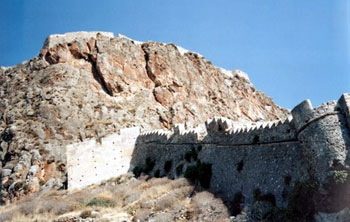 Methoni’s 15th century Venetian fortress expands over the whole area of the south west cape. Built over ancient walls, it was the prize of many invaders over the ages. The walls loom imposingly over a setting filled with memories of the past. The castle has a protective moat on the land side and is surrounded on three sides by the sea making it impenetrable.
Methoni’s 15th century Venetian fortress expands over the whole area of the south west cape. Built over ancient walls, it was the prize of many invaders over the ages. The walls loom imposingly over a setting filled with memories of the past. The castle has a protective moat on the land side and is surrounded on three sides by the sea making it impenetrable.
I spent a day exploring the ruins. There are many spooky chambers, underground passages, cisterns, a ruined Turkish mosque and hamam, a cathedral and crumbling houses. A stone causeway leads out to the small octagonal Bourtzi castle on an adjacent islet. The coastline is jagged. Sharp rocks like teeth jut up from the sea. I wondered how many ships had floundered and smashed on those rocky shores?
The medieval port town which stood within the fortress walls was the Venetian’s first and longest-held possession in the Peloponnese and a stop-over for pilgrims en route to the Holy Land. The twin fortresses of Koroni and Methoni were known as “The Eyes of the Serene Republic”.
The town of Methoni itself is a traditional settlement of Venetian-styled houses and cobbled streets and unlike Koroni, is built on flat ground with two broad central streets. In the Middle Ages it was a hub of commerce, but now it’s a sleepy little town, quiet and friendly.
The tourist season was winding down, so there were few people around. It was my final evening in Methoni so I decided to have a sunset picnic. I packed a little picnic lunch: and a half litre of krasi to drink from a plastic wine goblet. I took along Italian music just to keep the Venetian theme.
I sat at the end of a ruined wall and watched the sun being swallowed by the sea. Traces of brilliant pink clouds hung over the horizon and opalescent beams of light shot eastward from the horizon. The wine-dark sea (yes, Homer was right. It is!) was dappled with the last of the light. A half moon was visible over my shoulder, and behind me the castle ramparts. It was sheer magic. What an unforgettable way to spend the last night of my Venetian castles tour.
If You Go:
By Bus:
There are several buses a day to the Peloponnese from Athens.
To Monamvasia: buses go via Sparta.
To Korono: buses go via Kalamata.
To Methoni: buses go via Pylos.
Accommodations:
Hotels and domatia are available at all three cities.
Camping:
Monamvasia: Camping Paradise paradise@otenet.gr – 3.5 km south of Gefyra.
Koroni: Camping Koroni 5 km. west of town.
Methoni: Camping Methoni on the beach.
Archaeological sites:
Monamvasia: The medieval town is inaccessible to cars and motorcycles. A free shuttle bus operates between the causeway and old Monamvasia from 7.30 a.m. – 10 p.m. June to September.
Koroni: The old castle is occupied by the Timios Prodromos Convent. You can stroll free in the small promontory below the castle.
Methoni: Entrance to the fortress is free. Open 8:30 – 5 pm. Tues. to Sat. and 9 – 5 pm on Sunday.
About the author:
W. Ruth Kozak is a travel journalist and historical fiction novelist. She got interested in the Venetian connection in Greece while traveling around the country on research trips and realized there was much more to Greece than the popular Classical and Bronze Age ruins. There are many castle ruins scattered throughout the country and islands and they are all well-worth taking the time to explore. She is the former editor and publisher of TravelThruHistory.com.
Photographs:
All photographs are by W. Ruth Kozak.

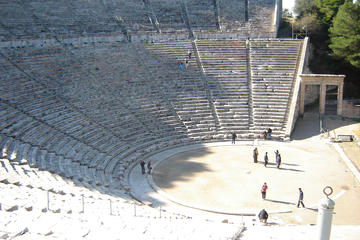

 Rising seventy metres on a black shale bench above the glacial silt plains of the River Boyne sit three megalithic tombs of the Neolithic or Late Stone Age also known as Passage Tombs or burial tombs. They date around 4000-2500 BC – Newgrange, Knowth and Dowth being the major ones – and are situated midway down the east side of Ireland.
Rising seventy metres on a black shale bench above the glacial silt plains of the River Boyne sit three megalithic tombs of the Neolithic or Late Stone Age also known as Passage Tombs or burial tombs. They date around 4000-2500 BC – Newgrange, Knowth and Dowth being the major ones – and are situated midway down the east side of Ireland. Passage Tombs have several common features: a mound in the shape of an egg called a tumulus. It is 85 meters across, 13 meters high and covers one acre. It is defined by a ring or kerb of 97 stones, a passage way and a chamber. I knew without doubt that this is where we got our word, curb which has the same basic use today – to define a certain boundary The building of the three Passage Tombs above the River Boyne seems to have developed over several hundreds of years, the design finally climaxing in the shaping of a cross. With a central space at the end of the passage way it also has a chamber on each side and also beyond it, making a very crude cross shape.
Passage Tombs have several common features: a mound in the shape of an egg called a tumulus. It is 85 meters across, 13 meters high and covers one acre. It is defined by a ring or kerb of 97 stones, a passage way and a chamber. I knew without doubt that this is where we got our word, curb which has the same basic use today – to define a certain boundary The building of the three Passage Tombs above the River Boyne seems to have developed over several hundreds of years, the design finally climaxing in the shaping of a cross. With a central space at the end of the passage way it also has a chamber on each side and also beyond it, making a very crude cross shape.
 Waiting for my group of ten to enter the passage way, I wandered around the outer path surrounding this UNESCO World Heritage Site. Returning to the opening I suddenly found myself alone. The site’s guide and the group had disappeared into the Tomb. I had to find a place to leave the umbrella and luggage and strapping my knapsack onto my chest I ducked low under the stone lintel of the entrance. All was darkness. I had to move sideways for most of the passage was very narrow. I could hear voices ahead. I was well aware that I was walking where my Irish ancestors had walked, where they had brought their dead to cremate. I finally came out to a dimly lit rounded chamber where a large three-spiral stone sat in a recessed part of the earth floor. Small chambers opened off the larger chamber to roughly take the shape of the cross. Three large stone basins, each about one metre wide were thought to have been used in cremation ritual. The tomb was plundered in the late 800’s AD by Viking raiders and after its recent excavation there is nothing left but the stone structure.
Waiting for my group of ten to enter the passage way, I wandered around the outer path surrounding this UNESCO World Heritage Site. Returning to the opening I suddenly found myself alone. The site’s guide and the group had disappeared into the Tomb. I had to find a place to leave the umbrella and luggage and strapping my knapsack onto my chest I ducked low under the stone lintel of the entrance. All was darkness. I had to move sideways for most of the passage was very narrow. I could hear voices ahead. I was well aware that I was walking where my Irish ancestors had walked, where they had brought their dead to cremate. I finally came out to a dimly lit rounded chamber where a large three-spiral stone sat in a recessed part of the earth floor. Small chambers opened off the larger chamber to roughly take the shape of the cross. Three large stone basins, each about one metre wide were thought to have been used in cremation ritual. The tomb was plundered in the late 800’s AD by Viking raiders and after its recent excavation there is nothing left but the stone structure. During the early days of Newgrange’s excavation there was a growing belief that the rising sun, at some unknown time, used to light up the three-spiral stone at the end of the passage. Finally on December 21st, 1969, the excavating crew investigated this idea. They recorded that the sun appeared above the horizon and a small shaft of light about the width of a pencil entered the roof-box. It was an aperture like as in a camera, l meter by 0.25 meter, and had been built behind the first lintel and below the second. This very narrow shaft of light shone along the whole passage to reach to one of the basin stones in the end chamber. Quite quickly the light widened to a 17 cm shaft and swung with a life of its own across the end chamber and the tomb was entirely lit. Shortly this 17 cm band of light narrowed and finally ceased to shine at all into the tomb. The tomb was again in darkness. For seventeen minutes, it was recorded, direct light entered Newgrange, not through the main door but through the specially designed slit which laid under the roof-box at the outer rim of the passage. It was most obvious that a specialized ritual of bringing the light into the tomb during the winter months was established. Since the burial tombs were a place of reverencing the dead, it is thought that the purposeful entering of the light was possibly symbolically giving the dead a passageway to the afterlife. Six thousand years ago, our ancestors had developed a ritual honoring the winter solstice—the sun’s rising on the shortest day of the year. I was in awe at the knowledge these ancient ones had possessed and had passed to us. I stood where ancient ritual had taken place and felt part of the eternal link that connected us all and I felt gratitude.
During the early days of Newgrange’s excavation there was a growing belief that the rising sun, at some unknown time, used to light up the three-spiral stone at the end of the passage. Finally on December 21st, 1969, the excavating crew investigated this idea. They recorded that the sun appeared above the horizon and a small shaft of light about the width of a pencil entered the roof-box. It was an aperture like as in a camera, l meter by 0.25 meter, and had been built behind the first lintel and below the second. This very narrow shaft of light shone along the whole passage to reach to one of the basin stones in the end chamber. Quite quickly the light widened to a 17 cm shaft and swung with a life of its own across the end chamber and the tomb was entirely lit. Shortly this 17 cm band of light narrowed and finally ceased to shine at all into the tomb. The tomb was again in darkness. For seventeen minutes, it was recorded, direct light entered Newgrange, not through the main door but through the specially designed slit which laid under the roof-box at the outer rim of the passage. It was most obvious that a specialized ritual of bringing the light into the tomb during the winter months was established. Since the burial tombs were a place of reverencing the dead, it is thought that the purposeful entering of the light was possibly symbolically giving the dead a passageway to the afterlife. Six thousand years ago, our ancestors had developed a ritual honoring the winter solstice—the sun’s rising on the shortest day of the year. I was in awe at the knowledge these ancient ones had possessed and had passed to us. I stood where ancient ritual had taken place and felt part of the eternal link that connected us all and I felt gratitude.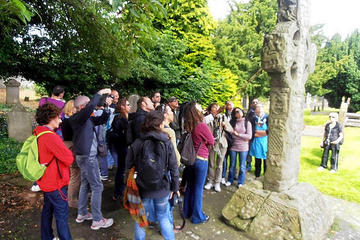
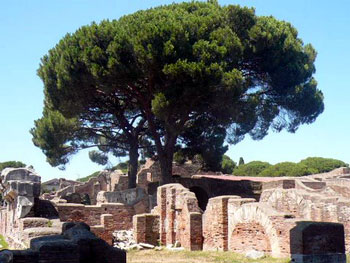
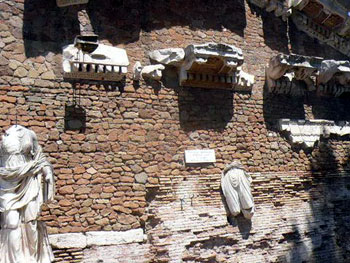 The Italian government has done a great job instructing visitors with strategically placed information about the site. We also liked the fact that they give you the freedom to discover Ostia on your own. Signs warn visitors to have respect for the artifacts. Because of atmospheric exposure and those created by the nearby airport, some of the monuments are wearing down. We wandered off the Decumanus, and. onto narrow paths scattered with pine needles, ducking under archways, and poking around alleys.
The Italian government has done a great job instructing visitors with strategically placed information about the site. We also liked the fact that they give you the freedom to discover Ostia on your own. Signs warn visitors to have respect for the artifacts. Because of atmospheric exposure and those created by the nearby airport, some of the monuments are wearing down. We wandered off the Decumanus, and. onto narrow paths scattered with pine needles, ducking under archways, and poking around alleys.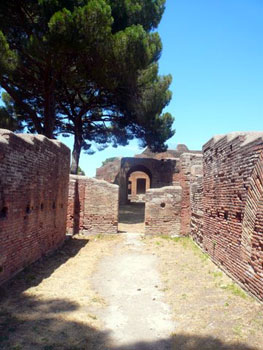 Just beyond the warehouses we climbed the few steps on our right. Here were the Baths of Neptune, a gathering place for the locals. An amazingly preserved mosaic, measuring 55 feet by 36 feet, is of the sea god riding a chariot drawn by four pawing horses.
Just beyond the warehouses we climbed the few steps on our right. Here were the Baths of Neptune, a gathering place for the locals. An amazingly preserved mosaic, measuring 55 feet by 36 feet, is of the sea god riding a chariot drawn by four pawing horses. We pictured the locals sitting in baths, then walking down the Maximus to imbibe a few cups of wine at the Insula of the Thermopolium.
We pictured the locals sitting in baths, then walking down the Maximus to imbibe a few cups of wine at the Insula of the Thermopolium.
 After navigating almost the length of the Maximus, we came to the Forum, the main square of the town. Here were the remains of important government and religious buildings. Many of the pillars and building foundations have been left standing. The huge Capitolium Temple dominates the right-hand side. Most Roman forums were dominated by a temple – to bring the deity to the people. The Capitolium Temple was dedicated to the pagan trinity of Juno, Jupiter and Minerva. Columns flank the massive staircase leading to the entrance. At least two stories are visible. Before heading back, we stopped at the near-by museum to view the busts and statues of the local citizenry. Most amazing is the detail to features, hair styles, and dress. My favorite was a soldier in a pleated kilt, headpiece, shoes, and weapon. There is also a room with more of the marble sarcophagi showing carvings of Dionysus, the Greek God of wine.
After navigating almost the length of the Maximus, we came to the Forum, the main square of the town. Here were the remains of important government and religious buildings. Many of the pillars and building foundations have been left standing. The huge Capitolium Temple dominates the right-hand side. Most Roman forums were dominated by a temple – to bring the deity to the people. The Capitolium Temple was dedicated to the pagan trinity of Juno, Jupiter and Minerva. Columns flank the massive staircase leading to the entrance. At least two stories are visible. Before heading back, we stopped at the near-by museum to view the busts and statues of the local citizenry. Most amazing is the detail to features, hair styles, and dress. My favorite was a soldier in a pleated kilt, headpiece, shoes, and weapon. There is also a room with more of the marble sarcophagi showing carvings of Dionysus, the Greek God of wine.

 We headed for this scenic route, officially inaugurated on 25 May 1975, on a sunny day in July. It took us less than one hour, by taking the N13 from Caen, to reach the starting point of the Cider Route, Cambremer.
We headed for this scenic route, officially inaugurated on 25 May 1975, on a sunny day in July. It took us less than one hour, by taking the N13 from Caen, to reach the starting point of the Cider Route, Cambremer. Cider-makers on the Cider Route compete annually and those selected display the sign “Cru de Cambremer” on the roadside at the entrances to their farms. Nineteen producers have been awarded the “Cru de Cambremer” in 2010 and nine of them offer guided tours. The specified products of these “Cru de Cambremer” can be marketed under the label Cidre du Pays d’Auge (AOC), Cidre du Pays d’Auge Cambremer (AOC) or Calvados du Pays d’Auge (AOC).
Cider-makers on the Cider Route compete annually and those selected display the sign “Cru de Cambremer” on the roadside at the entrances to their farms. Nineteen producers have been awarded the “Cru de Cambremer” in 2010 and nine of them offer guided tours. The specified products of these “Cru de Cambremer” can be marketed under the label Cidre du Pays d’Auge (AOC), Cidre du Pays d’Auge Cambremer (AOC) or Calvados du Pays d’Auge (AOC).
 Our next stop was the distillery for making calvados – an apple brandy produced from cider by double distillation. The liquid, which was just 10% in volume of the pre-distilled cider, was kept in large oak barrels between three and 30 years to give different brands of calvados.
Our next stop was the distillery for making calvados – an apple brandy produced from cider by double distillation. The liquid, which was just 10% in volume of the pre-distilled cider, was kept in large oak barrels between three and 30 years to give different brands of calvados.
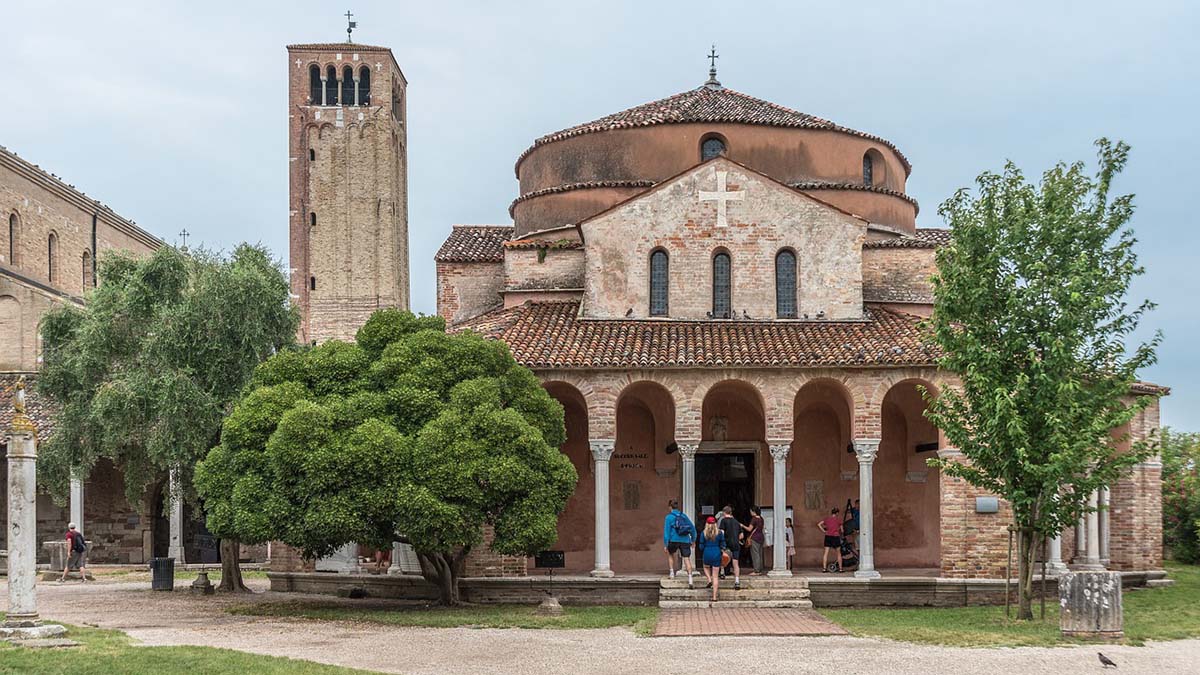
 Out here in the open, away from the confines of the city, the unique light of the Veneto takes centre stage and the whole lagoon becomes bathed in pure luminosity. It is a scene of wide horizons where sea and sky merge into a pool of rainbow like reflections. The light continuously shifts and I am lulled into a tranquil, hypnotic state, lost in an other world of translucence.
Out here in the open, away from the confines of the city, the unique light of the Veneto takes centre stage and the whole lagoon becomes bathed in pure luminosity. It is a scene of wide horizons where sea and sky merge into a pool of rainbow like reflections. The light continuously shifts and I am lulled into a tranquil, hypnotic state, lost in an other world of translucence. Torcello was the first island to be settled in the lagoon, long before the present day Venice. Its origins are founded on a series of mystical revelations. The people of the lagoon were originally from the Roman city of Altino which came under threat in the 5th century from barbarian invasion. As the Germanic hordes from the north approached Altino many of the residents fled in blind terror, but some remained under the leadership of the Bishop who waited for divine inspiration.
Torcello was the first island to be settled in the lagoon, long before the present day Venice. Its origins are founded on a series of mystical revelations. The people of the lagoon were originally from the Roman city of Altino which came under threat in the 5th century from barbarian invasion. As the Germanic hordes from the north approached Altino many of the residents fled in blind terror, but some remained under the leadership of the Bishop who waited for divine inspiration. Until the 10th century Torcello was the greatest commercial centre in the lagoon, full of palaces, churches and even a grand canal. Like the lost mythical Camelot, Torcello offers a tantalizing glimpse of a golden utopia, where an egalitarian social hierarchy developed which was uniquely progressive for the time. Cassiodorious wrote “There is no distinction between rich and poor, the same food for all; the houses are all alike and so envy – that vice which rules the world – is absent here.” Here we see the roots of the liberal democracy which became such a feature of the Venetian Republic.
Until the 10th century Torcello was the greatest commercial centre in the lagoon, full of palaces, churches and even a grand canal. Like the lost mythical Camelot, Torcello offers a tantalizing glimpse of a golden utopia, where an egalitarian social hierarchy developed which was uniquely progressive for the time. Cassiodorious wrote “There is no distinction between rich and poor, the same food for all; the houses are all alike and so envy – that vice which rules the world – is absent here.” Here we see the roots of the liberal democracy which became such a feature of the Venetian Republic. Today Torcello is largely deserted with probably no more than twenty people who are actual permanent residents here. It has a rustic and decaying atmosphere with just a few houses dotted about among the overgrown meadows leaving the island in an other worldly limbo of tranquil silence. Apart from a few farmers with small holdings most of the people who work here are involved with the tourists who come to see the few places of interest remaining on the island: the two churches. a small museum and the restaurant.
Today Torcello is largely deserted with probably no more than twenty people who are actual permanent residents here. It has a rustic and decaying atmosphere with just a few houses dotted about among the overgrown meadows leaving the island in an other worldly limbo of tranquil silence. Apart from a few farmers with small holdings most of the people who work here are involved with the tourists who come to see the few places of interest remaining on the island: the two churches. a small museum and the restaurant. Next to the cathedral is the little church of Santa Fosca. This simple but charming Romanesque construction provides the setting for romantic weddings which are discreetly open to public view. In Venice it is so easy to casually become part of some intimate and private ritual. I remember being here once when a wedding was taking place and a crowd of people were milling around, peeping into the church with hushed curiosity. I had earlier seen the bride arriving in traditional Venetian mode: the young beauty standing motionless in her gondola, a vision in white, drifting gracefully along the canal.
Next to the cathedral is the little church of Santa Fosca. This simple but charming Romanesque construction provides the setting for romantic weddings which are discreetly open to public view. In Venice it is so easy to casually become part of some intimate and private ritual. I remember being here once when a wedding was taking place and a crowd of people were milling around, peeping into the church with hushed curiosity. I had earlier seen the bride arriving in traditional Venetian mode: the young beauty standing motionless in her gondola, a vision in white, drifting gracefully along the canal.
